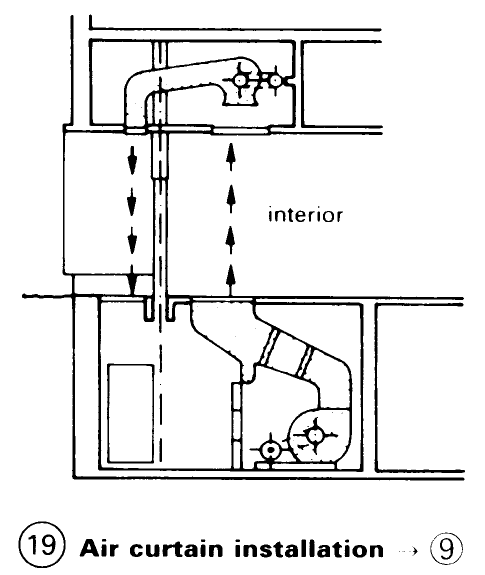Doors: Internal. Doors: Size and Frames. Revolving and Slinding Doors
Internal doors must be positioned in order to maximise the usable room space (1) – (8). It IS necessary to decide whether a door should open inwards or outwards. Normally doors open into the room – (25). Door types are named according to their construction, position and purpose. A balanced door – (23) + (24) requires little strength to open it, and is well suited for corridors.




The width of a door is determined by its use and the room into which it leads. The minimum inside width of a door opening is 55cm. In residential buildings the standard door opening widths are as follows. Single-panel doors: main rooms approx. 80cm; auxiliary rooms approx. 70cm; front doors to flats approx. 90cm; front doors to houses up to 115cm. Double doors: main rooms approx. 170cm; front doors 140-225cm. Door opening height at least 185cm, but normally 195-200cm. Sliding and revolving doors are not permitted for escape or exit doors, as they could block the route in an emergency.
Disabled persons have special requirements. The minimum convenient door width for the ambulant disabled is 80cm. This is too narrow for wheelchair users, but 90cm is usually adequate. There should be adequate space to position a wheelchair beside the door. Corridors should be not less than 120cm wide so that wheelchair users can position themselves to open a door in the end wall of a corridor or at the side. An end door should be offset to give maximum space beside the handle. Similarly, when a door is located in the corner of a room, it should be hinged at the side nearer the corner.
Doors: Size and Frames. The sizes of wall apertures for doors - (1) are nominal standard building sizes. If, in exceptional cases, other sizes are necessary, the building standard size for them must be whole number multiples of 125mm (100mm according to British Standards). Steel frames can be used as left- as well as right-hand frames – (10).


Revolving and Slinding Doors. Revolving doors are made in several different designs - (1) - (6). Some are adjustable, e.g. when the number of users is large, particularly in the summer, the panels can be folded into the middle to allow people to go in on one side and out on the other at the same time. Some designs have panels which can be pushed to the side if traffic is only in one direction (e.g. when business closes for the day).

Actuating devices for automatic doors can be controlled by radar, electric contact mats (7) - (8) or pneumatic floor contacts. Unidirectional or reflecting light barriers controlling automatic sliding doors with six panels up to 8m wide are ideal for installation on emergency escape routes in office blocks, public buildings and supermarkets. Air curtain doors – (19) can be shut off at night by a raised door -> (9).



Room dividers can be provided by the use of folding doors, guided from the side (10). Concertina doors are centrally hung - (11) for closing off wide openings. A revolving movement can be combined with a sliding movement. Accordion doors can be made of plywood, artificial leather or cloth – (12).

Date added: 2023-01-01; views: 781;
